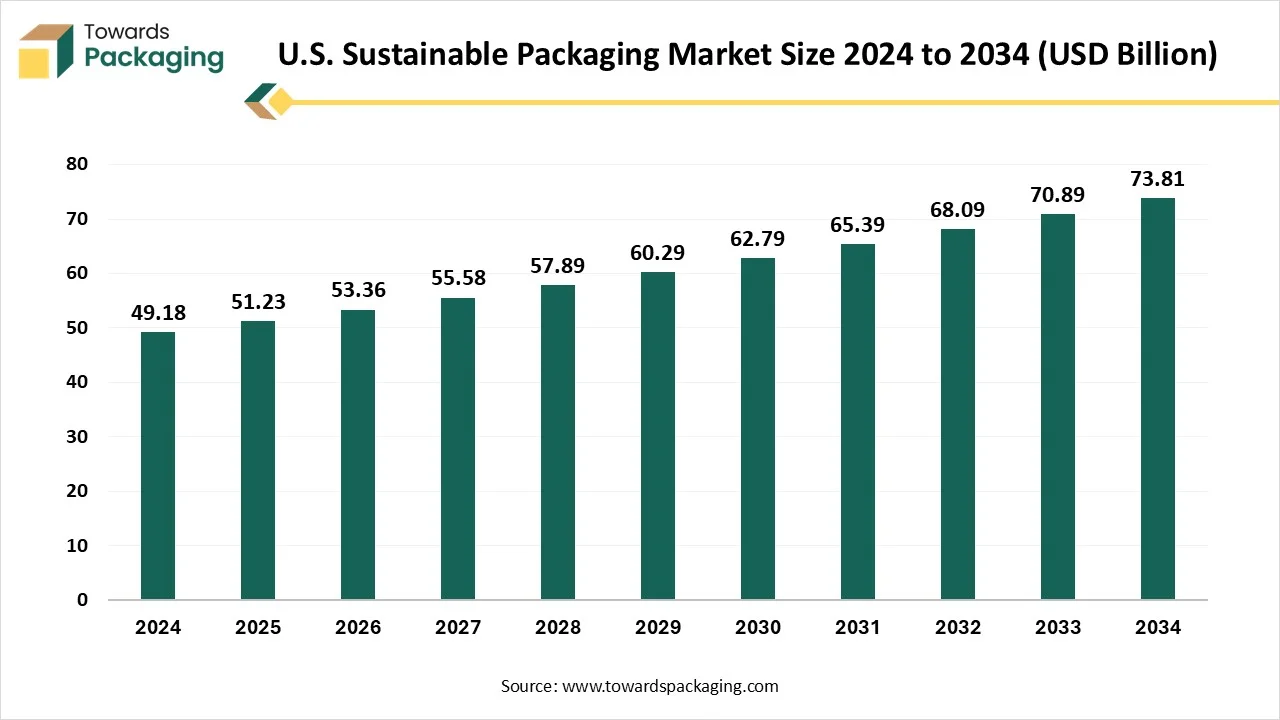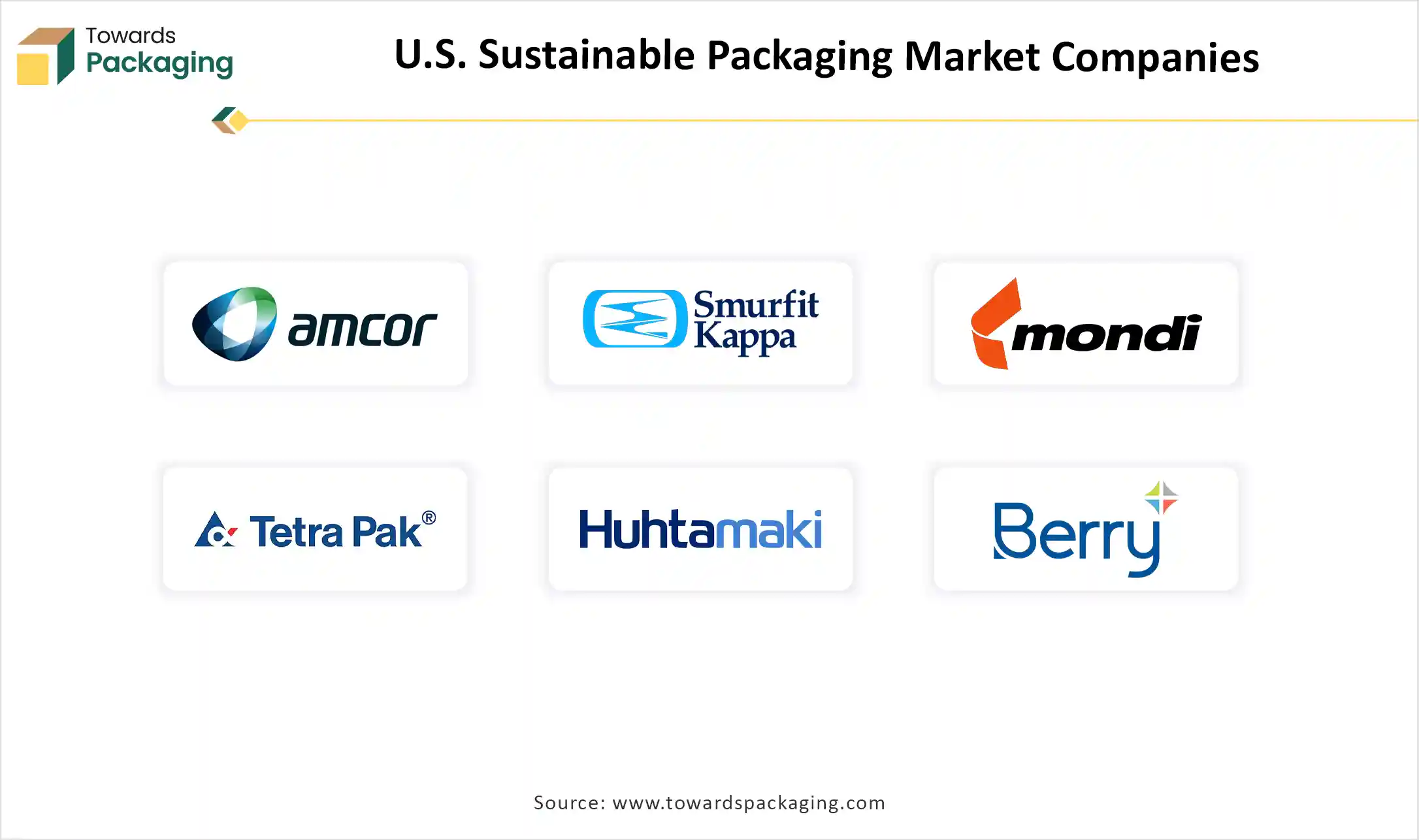December 2025
The U.S. sustainable packaging market is predicted to expand from USD 51.23 billion in 2025 to USD 73.81 billion by 2034, growing at a CAGR of 4.15% during the forecast period from 2025 to 2034. The increasing awareness regarding the environmental impact of plastic packaging materials is expected to drive the global U.S. sustainable packaging market over the forecast period.

Sustainable packaging refers to any eco-friendly material that is widely used to store, wrap, ship, and shelf products. Sustainable packaging focuses on the development and use of packaging solutions that are generally made from materials such as recyclable PET or HDPE plastics, paper, and cardboard. It also includes compostable materials such as PLA (a starch-based material) and cellulose, which biodegrade in compost, providing an eco-friendly alternative. Sustainable Packaging has a minimal environmental impact and footprint through the use of renewable or recycled resources.
According to the article published in April 2024, the United States produces nearly 40 million tons of plastic waste annually, much of it in the form of packaging materials, and current data suggests that only around five percent of plastic waste is recycled. Nearly 40 percent of plastic waste in the U.S. comes from packaging, contributing to pollution, landfills, and the spread of micro- and nano-plastics. Supported by the U.S. National Science Foundation (NSF) with an initial five-year grant, the Michigan State University School of Packaging (SoP) has launched the new Center for Plastic, Paper, and Hybrid Packaging End-of-Life Solutions (C3PS) to explore novel solutions to the challenges posed by plastic and plastic-coated paper waste.
| Company Name | Ticker / Exchange | Country | Market Cap (USD B) | P/E Ratio | Price-to-Sales (P/S) | EV / EBITDA | Dividend Yield (%) | Revenue (Last FY) | EBITDA (Last FY) | Employees | Sustainable Packaging Focus |
| Ball Corporation | BALL (NYSE) | USA | 13.1 | 23.86× | — | — | — | USD 11.8 B | — | 16,000 | Leading aluminum packaging provider with strong focus on recycling and sustainability in packaging materials. |
| Avery Dennison Corp. | AVY (NYSE) | USA | 17.7 | 20.8× | 9.1× | 13.2× | 1.92% | USD 7.23 B | — | 36,000 | Invests in sustainable labels and adhesive flexible films with an emphasis on reducing environmental impact. |
| Sonoco Products Co. | SON (NYSE) | USA | 6.2 | 12.5× | 1.8× | 7.4× | 100.00% | USD 7.26 B | — | 22,000 | Focuses on paper-based and sustainable flexible packaging solutions, including eco-friendly food packaging. |
| Berry Global Group Inc. | BERY (NYSE) | USA | 7.1 | 15.8× | 2.7× | 7.9× | 74.00% | USD 13.3 B | — | 46,000 | Expanding portfolio in sustainable flexible packaging, focusing on recycled and renewable plastic content. |
| Sealed Air Corp. | SEE (NYSE) | USA | 5.8 | 13.2× | 5.4× | 8.7× | — | USD 5.6 B | — | 16,300 | Protective and flexible films, with growing focus on sustainable and recyclable packaging materials. |
| Graphic Packaging Holding Co. | GPK (NYSE) | USA | 8.7 | 10.6× | 2.1× | 6.9× | 77% | USD 9.3 B | — | 24,000 | Focuses on sustainable cartonboard and flexible wraps, committed to sourcing renewable materials. |
| Packaging Corp. of America | PKG (NYSE) | USA | 17.5 | 17.2× | 3.5× | 9.8× | 1% | USD 8.76 B | — | 15,000 | Strong focus on sustainable corrugated packaging, with efforts to reduce plastic and improve recyclability. |
| International Paper Co. | IP (NYSE) | USA | 14.8 | 19.6× | 2.2× | 7.1× | 1% | USD 18.8 B | — | 39,000 | Focuses on paper-based and flexible products, with growing emphasis on sustainability and renewable materials. |
| Dow Inc. | DOW (NYSE) | USA | 42.9 | 18.3× | 2.1× | 7.6× | 1% | USD 45 B | — | 35,900 | Leading in polyethylene film and packaging materials, increasingly focused on developing sustainable plastics solutions. |
As technology continues to evolve, AI integration holds great potential to reshape the U.S. sustainable packaging market. Artificial intelligence (AI) integration in sustainable packaging solutions is paving the way for effective biodegradable materials and alternatives that significantly reduce environmental emissions and promote circularity in the packaging industry landscape. AI algorithms and advanced materials science allow researchers to develop sustainable packaging materials that conserve resources, minimize waste, and safeguard the Earth for future generations. AI-powered automated recycling systems provide a systematic and innovative approach to address the issue of packaging waste. The utilization of advanced algorithms can identify, sort, and process recyclable materials effectively. AI also assists in identifying and eliminating non-recyclable on non-biodegradable materials, and promotes sustainable packaging practices across various industries.
Increasing Consumer Preference for Sustainable and Eco-friendly Packaging Solutions
The increasing consumer preference for sustainable and eco-friendly packaging solutions is expected to boost the growth of the U.S. sustainable packaging market during the forecast period. Consumers are increasingly preferring eco-friendly and sustainable packaging solutions by replacing traditional packaging materials, such as plastics and polystyrene, which contribute to an increase in pollution levels, marine debris, and landfill overflow, posing threats to both human health and ecosystems. Plastic takes nearly 1000 years to decompose.
Sustainable packaging material offers an eco-friendly alternative to traditional plastic and is specifically designed to be recycled and reused. These materials are widely used across various applications, from food containers and cutlery to flexible packaging and the fashion industry, offering environmental benefits. The adoption of sustainable packaging solutions by businesses in reducing their carbon footprint and becoming more environmentally conscious.
The rising environmental concern has encouraged businesses to invest in eco-friendly packaging solutions. For instance, in March 2025, Saica Group announced its plan to invest 110 million into a U.S. plant for a corrugated packaging facility in the United States and produce over 1,200,000 MSF of corrugated packaging from 2026. Thus, driving the expansion of the U.S. sustainable packaging market during the forecast period.
Higher Costs of Sustainable Packaging Materials
The high cost of sustainable packaging materials is anticipated to hinder the market’s growth. The lower availability of sustainable packaging materials has led to an increase in the price of sustainable packaging solutions. The limited availability of sustainable packaging materials often results in supply shortages and inconsistency in the supply chain. This also hampers the company's production schedules and evolving demands, leading to delays and increased costs. Such factors may restrict the expansion of the global U.S. sustainable packaging market.
How are the Government Initiatives Impacting the Growth of the Market?
The supportive government initiatives related to sustainable packaging are projected to offer lucrative growth opportunities to the growth of the U.S. sustainable packaging market in the coming years. Environmental sustainability has gained immense momentum, particularly in the packaging industry. The stringent regulations and policies of the country that focus on reducing single-use plastics and push businesses to adopt sustainable packaging solutions. The government has taken effective measures to reduce the use of traditional plastics and encourage the usage of biodegradable, recyclable, or compostable alternatives.
The U.S. Environmental Protection Agency (EPA) offers grants aimed at promoting sustainable materials management, which can include innovative packaging solutions. In addition to government funding, private foundations and non-profit organizations also provide grants specifically for sustainability initiatives. When it comes to funding sustainable packaging innovations, Government grants aim to support research and development in sustainable technologies and offer financial assistance to companies that are pioneering new eco-friendly materials or processes.
The paper segment held a dominant presence in the U.S. sustainable packaging market in 2024, due to its affordability, cost-effectiveness, and versatility. Paper is the most dominant material in the sustainable packaging sector, due to the increasing consumer preferences towards paper pouches, bags, and other packaging forms. Consumers and businesses increasingly choose paper-based packaging, owing to its eco-friendliness, such as compostability and recyclability, as well as offering a wide range of benefits. The paper completely aligns with the principles of the circular economy.
Additionally, several clothing brands, packaged food product companies, healthcare, personal care, and other end-users are focused on promoting sustainable packaging by addressing the rising environmental concerns. On the other hand, plastic is expected to witness a significant share during the forecast period, owing to increasing demand for recycled plastic material for various end-user industries. Moreover, plastic material is widely utilized as sustainable packaging, owing to its versatility, cost-effectiveness, and lightweight properties. Sustainable plastic packaging includes using recycled plastic, bioplastics (PLA, PHA), and compostable alternatives. It aims to reduce environmental impact through materials, processes, and disposal methods. Plastics are cheaper to produce than other materials, such as metal or glass. Plastic packaging materials are reducing transportation costs and significantly reducing carbon emissions associated with shipping.
The recycled packaging segment dominated the market with the largest share in 2024. The growth of the segment is mainly driven by the rising environmental concerns, increasing adoption of advanced technology, and growing focus on corporate responsibility. Additionally, increasing government initiatives and regulations that support the development of recycling plants, including the use of recycled packaging materials, are expected to further boost the industry's expansion. On the other hand, the reusable packaging type segment is expected to grow at a significant rate, owing to the increasing adoption of reusable packaging by companies as a sustainable and profitable solution. Reusable packaging exhibits several key characteristics which including durability, cleanability, stackability, and compatibility. Reusable packaging is intended to be returned and refilled for repeated use, lowering the need for continuous production. The embracing of reusable packaging systems presents several benefits for businesses, ranging from environmental advantages to economic gains.
The food and beverage segment is dominating the market over the U.S. sustainable packaging market in 2024, owing to the rapid expansion of the food industry, coupled with the rising awareness about environmental concerns. Sustainable food and beverage packaging increases the use of renewable resources, such as bioplastics, biodegradable, or compostable materials. These materials assist in reducing dependency on finite resources and significantly contribute to a circular economy. Moreover, the adoption of sustainable packaging in the food and beverage industry involves using materials that lower environmental impact while also ensuring food safety and product protection. On the other hand, the personal care segment is expected to witness remarkable growth during the forecast period, owing to the rising consumer preferences and increasing focus on sustainability. Consumers and businesses are increasingly concerned about the environmental impact of products, which has led to an increasing demand for sustainability.

By Material
By Packaging Type
By Application
December 2025
December 2025
December 2025
December 2025